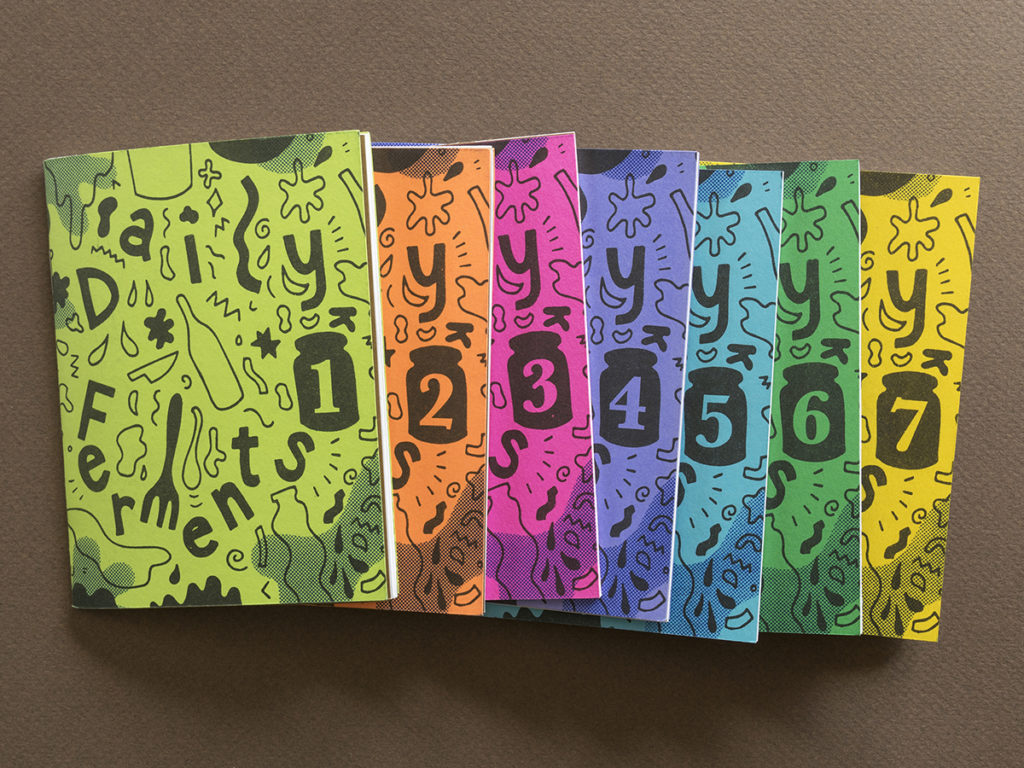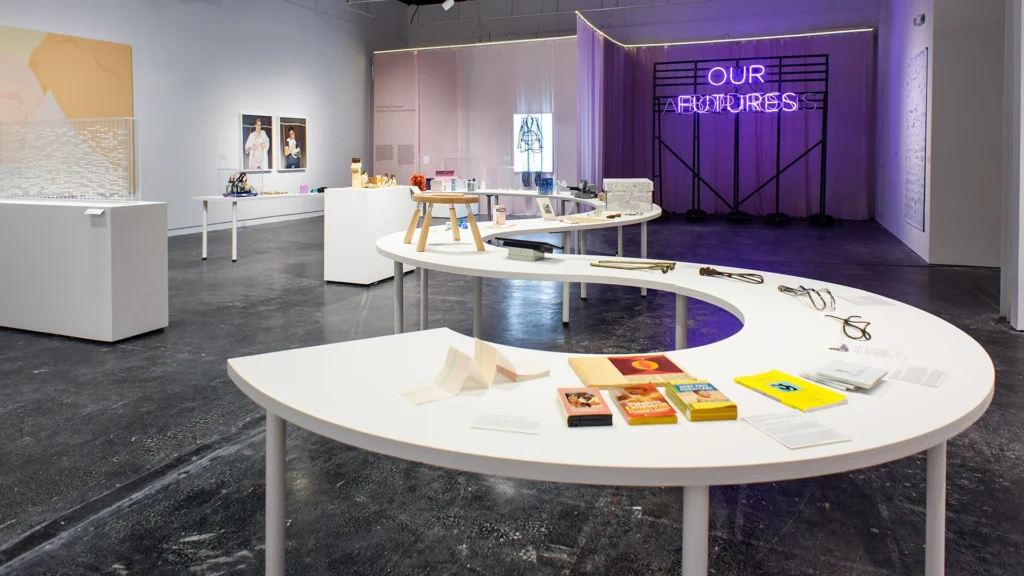**Please note: HCCC will be closed to the public Christmas Day through New Year’s Day (Dec. 25 – Jan. 1), for staff holidays.**
Jump to virtual learning content and related events.
Copy Culture: Zines Made and Shared celebrates the history, practice, and community of self-described “zinesters.” Zines, which are small circulation booklets created and distributed by individuals or small groups, are set apart from mainstream publishing by a lack of formal barriers to participation. For decades, zines have brought together and created space for marginalized, underrepresented, and dissident voices to share knowledge and find community. Copy Culture features zines and ephemera from Texas and beyond, inviting visitors to learn more by doing it themselves.
Born in the age of “snail mail,” zines now enjoy wide popularity and distribution online. Nevertheless, many zinesters still cite zine festivals as the best outlet for community, commerce, and connection. The co-founders of San Anto Zine Fest, Natasha I. Hernandez and Isabel Ann Castro, also produced the long-running submission-based zine, St. Sucia, which captured the complicated, beautiful reality of what 21st-century Latinx identity looks like through the eyes of its community of devoted fans, known as sucias. They write, “We are a space for gente who identify as mujer, in any way they choose to.”
While the most recognizable graphic style associated with zines is tied to the use of collage and reappropriated content by movements like Fluxus and the Situationist International, zines today encompass a vast spectrum of styles and content. From the cinematic nickelodeon zines of Dallas-based Andy Hirsch to the lush climate-change-inspired comics drawn by Sarah Welch and printed by James Beard, of Houston-based Mystic Multiples, the fundamentals of zine-making provide a nearly limitless platform from which to explore and experiment.
Innumerable knowledge- and skill-sharing zines have created a vast repository of knowledge built by diverse voices across the globe, building solidarity by democratizing access to information and archiving the voices of historically underrepresented groups. In that tradition, Emily Halbardier and Erik Sultzer, of Houston-based The Center for Imaginative Cartography and Research, share knowledge about processes like fermentation, and New York-based Liza Stark merges technology with the zine’s simple paper format to create a how-to manual for circuitry that lights up.
Perpetually hailed as being “back” and in vogue once again, zines have been a consistent outlet for a variety of communities, from sci-fi enthusiasts to LGBTQ+ writers and artists, since long before the term zine was coined in 1940. Curatorial Fellow María-Elisa Heg comments, “One of the most easily accessible and enduring forms of making, self-publishing is as old as printing itself. Yet, zines remain contemporary, as each rediscovery of this versatile medium brings new ideas, new voices, and new connections to history.”
As part of its exhibition programming, HCCC will invite the public to watch zine-making demonstrations and make their own zines using simple materials and techniques.
Copy Culture: Zines Made and Shared is curated by HCCC Curatorial Fellow María-Elisa Heg.
RELATED EVENTS
Copy Fest Zine Market & Demo with Sarah Welch
October 9, 11:00 AM – 3:00 PM
HOH To Go: Zines 101
November 6, 11:00 AM – 1:00 PM
“Copy Culture” Zine-Making Demo with Anastasia Kirages
November 6, 11:00 AM – 3:00 PM
We invite you to learn more about the exhibition by visiting the virtual learning content below.
LEARN
EXPLORE
Video: Andy Hirsch demonstrates how to read his zine, “Super Max: Muscle Fight Chronicles”
Video: Andy Hirsch reads through his zine, “Untitled”
Video: Andy Hirsch unfolds his zine, “Idle Threat”
Video: HCCC Curatorial Fellow María-Elisa Heg shows how to make a one-page zine
Image credits:
- The Center for Imaginative Cartography and Research, “Daily Ferments 1-7,” 2014-2015. Two-color Risograph on 65# Astrobright cover, black xerography on 70# Classic Crest text. 5″ x 3.75.” Courtesy of the artists.
- The Center for Imaginative Cartography and Research, “Found Tomorrow,” 2019. 3-color Risograph print. 11″x 17.”. Courtesy of the artists.
- The Center for Imaginative Cartography and Research, “Psychic Vent,” 2019. Mixed-media collage. 13.5″ x 18.75.” Courtesy of the artists.
- Andy Hirsch, “Super Max: Muscle Fight Chronicles,” 2009. Paper, laser print, book board, screenprint, wood. 5″ x 8.” Courtesy of the artist.
- Andy Hirsch, “Idle Threat,” 2009. Paper and laser print. 6″ x 8 1/2″ / 6″ x 10’11.” Courtesy of the artist.
- Andy Hirsch, “Untitled,” 2010. Paper, transparency, laser print. 4 1/2″ x 6 ¼.” Courtesy of the artist.
- Liza Stark, “Crafting a Path,” 2016. Card stock, paper, LED, copper tape, coin-cell battery, clip, silver stretch conductive fabric. 8.5×11 inches. Courtesy of the artist.
- Liza Stark, “Crafting a Path,” 2016. Card stock, paper, LED, copper tape, coin cell battery, clip, silver stretch conductive fabric. 8.5×11 inches. Courtesy of the artist.
- Isabel Ann Castro and Natasha I. Hernandez, “Centenos 3.” Photo by Destiny Mata.
- Isabel Ann Castro and Natasha I. Hernandez, “Centenos 2.” Photo by Destiny Mata.
- Isabel Ann Castro and Natasha I. Hernandez, “Centenos 1.” Photo by Destiny Mata.
- Sarah Welch, “Holdouts” and “Holdouts: Giveth and Taketh,” 2017 and 2019. Risograph printed comics. Courtesy of the artist.
- Sarah Welch, “Crypt Iguana” (detail), 2019. Risograph printed comic. 10″ x 6.75.” Courtesy of the artist.
- Sarah Welch, “Crypt Iguana,” 2019. Risograph printed comic. 10″ x 6.75.” Courtesy of the artist.

